
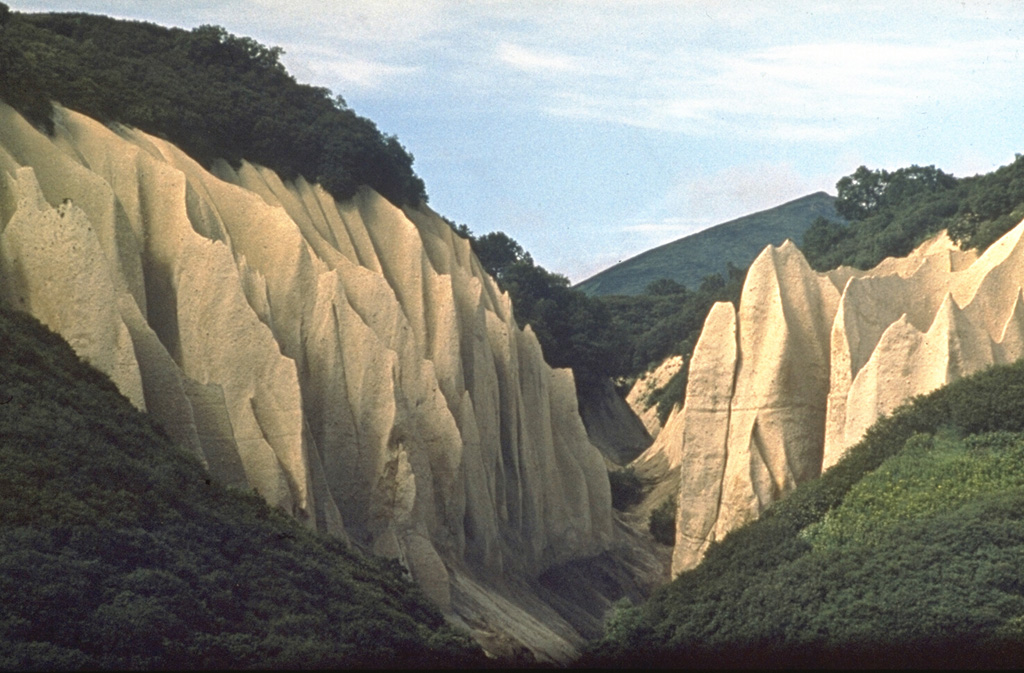
The Global Volcanism Program has no activity reports available for Kurile Lake.
The Global Volcanism Program has no Weekly Reports available for Kurile Lake.
The Global Volcanism Program has no Bulletin Reports available for Kurile Lake.
|
|
||||||||||||||||||||||||||||
There is data available for 2 confirmed eruptive periods.
6440 BCE ± 25 years Confirmed Eruption (Explosive / Effusive) VEI: 7
| Episode 1 | Eruption (Explosive / Effusive) | Tephra layer KO | |||||||||||||||||||||||||||||||||||||||||||||||||||||
|---|---|---|---|---|---|---|---|---|---|---|---|---|---|---|---|---|---|---|---|---|---|---|---|---|---|---|---|---|---|---|---|---|---|---|---|---|---|---|---|---|---|---|---|---|---|---|---|---|---|---|---|---|---|---|
| 6440 BCE ± 25 years - Unknown | Evidence from Isotopic: 14C (calibrated) | |||||||||||||||||||||||||||||||||||||||||||||||||||||
|
List of 9 Events for Episode 1 at Tephra layer KO
|
||||||||||||||||||||||||||||||||||||||||||||||||||||||
7550 BCE ± 500 years Confirmed Eruption (Explosive / Effusive)
| Episode 1 | Eruption (Explosive / Effusive) | ||||||||||||||||||||||||
|---|---|---|---|---|---|---|---|---|---|---|---|---|---|---|---|---|---|---|---|---|---|---|---|---|
| 7550 BCE ± 500 years - Unknown | Evidence from Correlation: Tephrochronology | |||||||||||||||||||||||
|
List of 3 Events for Episode 1
|
||||||||||||||||||||||||
This compilation of synonyms and subsidiary features may not be comprehensive. Features are organized into four major categories: Cones, Craters, Domes, and Thermal Features. Synonyms of features appear indented below the primary name. In some cases additional feature type, elevation, or location details are provided.
Synonyms |
||||
| Kurilskoe, Lake | Kuril Lake | ||||
Domes |
||||
| Feature Name | Feature Type | Elevation | Latitude | Longitude |
| Chayachii | Dome | |||
| Serdtze Alaida
Heart of Alaid |
Dome | |||
| Tugumynk | Dome | |||
 This renowned exposure of pyroclastic flow deposits from Kurile Lake caldera has been named Kutkhiny Baty because of its erosional features. The pyroclastic flow deposit originated from the caldera-forming eruption of Kurile Lake about 7,600 years ago, one of the largest Holocene eruptions in Kamchatka. The deposit is about 100 m thick at this location on the Ozernaya River, 3 km W of Kurile Lake.
This renowned exposure of pyroclastic flow deposits from Kurile Lake caldera has been named Kutkhiny Baty because of its erosional features. The pyroclastic flow deposit originated from the caldera-forming eruption of Kurile Lake about 7,600 years ago, one of the largest Holocene eruptions in Kamchatka. The deposit is about 100 m thick at this location on the Ozernaya River, 3 km W of Kurile Lake.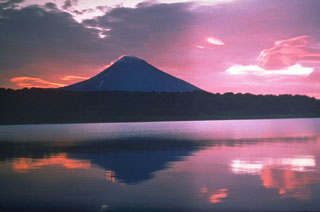 Iliinsky volcano at sunrise above the NE shore of Kurile Lake, was constructed beginning about 8,000 years ago within a 4-km-wide caldera of about the same age as the Kurile Lake caldera. It is one of several visible from the shores of one of Kamchatka's most scenic lakes. Its latest eruption, in 1901, created a 1-km-wide crater on the NE flank. The 10-km-wide Kurile Lake caldera was the source of one of Kamchatka's largest Holocene explosive eruptions about 7,600 years ago.
Iliinsky volcano at sunrise above the NE shore of Kurile Lake, was constructed beginning about 8,000 years ago within a 4-km-wide caldera of about the same age as the Kurile Lake caldera. It is one of several visible from the shores of one of Kamchatka's most scenic lakes. Its latest eruption, in 1901, created a 1-km-wide crater on the NE flank. The 10-km-wide Kurile Lake caldera was the source of one of Kamchatka's largest Holocene explosive eruptions about 7,600 years ago.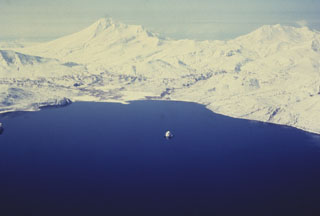 Kambalny (left-center) and Koshelev (far right) volcanoes rise above the Kurile Lake caldera to the SW, one of the scenic highlights of the Kamchatka Peninsula. Kambalny is the southernmost large volcano in Kamchatka. Both volcanoes have produced recent lava flows from flank vents on complex older structures. The small island in Kurile Lake caldera is the "Heart of Alaid," a rhyolitic lava dome.
Kambalny (left-center) and Koshelev (far right) volcanoes rise above the Kurile Lake caldera to the SW, one of the scenic highlights of the Kamchatka Peninsula. Kambalny is the southernmost large volcano in Kamchatka. Both volcanoes have produced recent lava flows from flank vents on complex older structures. The small island in Kurile Lake caldera is the "Heart of Alaid," a rhyolitic lava dome.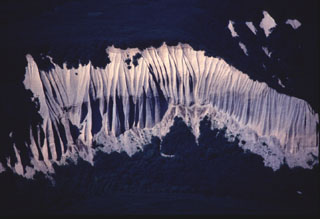 Erosion of unwelded pyroclastic flow deposits from Kurile Lake caldera formed these cliffs along the Ukanovich River, 10 km N of the caldera. Voluminous pyroclastic flows accompanying formation of the caldera about 7,600 years ago covered the area during one of the largest Holocene eruptions of the Kamchatka Peninsula.
Erosion of unwelded pyroclastic flow deposits from Kurile Lake caldera formed these cliffs along the Ukanovich River, 10 km N of the caldera. Voluminous pyroclastic flows accompanying formation of the caldera about 7,600 years ago covered the area during one of the largest Holocene eruptions of the Kamchatka Peninsula.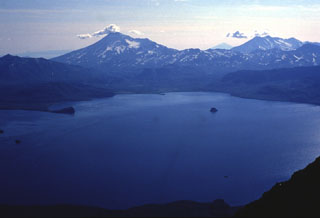 Kambalny (left) and Koshelev (right) rise above the SW shore of Kurile Lake caldera at the southern tip of Kamchatka. The caldera formed in two stages, the first about 41,500 radiocarbon years ago and the second about 7,600 years ago during one of Kamchatka's largest Holocene eruptions. The small island (right-center) is the lava dome referred to as the "Heart of Alaid”. The peak on the distant horizon at right-center is Alaid in the Kuril Islands.
Kambalny (left) and Koshelev (right) rise above the SW shore of Kurile Lake caldera at the southern tip of Kamchatka. The caldera formed in two stages, the first about 41,500 radiocarbon years ago and the second about 7,600 years ago during one of Kamchatka's largest Holocene eruptions. The small island (right-center) is the lava dome referred to as the "Heart of Alaid”. The peak on the distant horizon at right-center is Alaid in the Kuril Islands.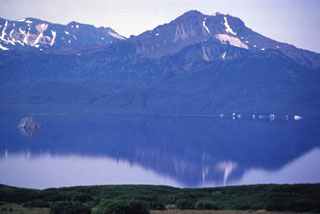 The Diky Greben lava dome complex rises above Kurile Lake caldera. Early eruptions took place about 6,000 years ago, about 2,000 years after formation of the 10-km-wide caldera. The eastern lava dome, seen here, opens to the E. Most of the edifice, including the unvegetated thick lava flow visible to the S (left) of the summit, was constructed about 2,000-1,500 years ago.
The Diky Greben lava dome complex rises above Kurile Lake caldera. Early eruptions took place about 6,000 years ago, about 2,000 years after formation of the 10-km-wide caldera. The eastern lava dome, seen here, opens to the E. Most of the edifice, including the unvegetated thick lava flow visible to the S (left) of the summit, was constructed about 2,000-1,500 years ago.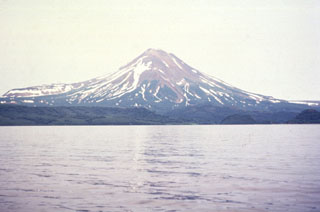 Iliinsky volcano, seen here across Kurile Lake from the SW at the outlet of the Ozernaya River, was constructed during the past 7,600 years above the NE rim of Kurile Lake caldera. The flat ridge with a steep terminus on the left horizon consists of north-flank lava flows that were emplaced about 1,500-2,000 years ago.
Iliinsky volcano, seen here across Kurile Lake from the SW at the outlet of the Ozernaya River, was constructed during the past 7,600 years above the NE rim of Kurile Lake caldera. The flat ridge with a steep terminus on the left horizon consists of north-flank lava flows that were emplaced about 1,500-2,000 years ago.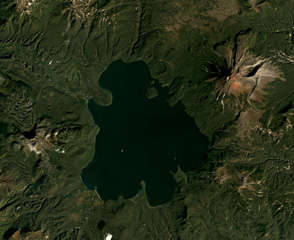 The Kurile Lake caldera, with Iliinsky volcano to the NE of the lake and Diky Greben to the W, is shown in this September 2019 Planet Labs satellite image monthly mosaic (N is at the top; this image is approximately 22 km across). The caldera formed during two large eruptions, with the more recent 7,600 14C yr BP eruption being one of the largest Holocene eruptions around the world. Surrounding the lake are the resulting ignimbrite deposits with some outcrops reaching 150 m thick.
The Kurile Lake caldera, with Iliinsky volcano to the NE of the lake and Diky Greben to the W, is shown in this September 2019 Planet Labs satellite image monthly mosaic (N is at the top; this image is approximately 22 km across). The caldera formed during two large eruptions, with the more recent 7,600 14C yr BP eruption being one of the largest Holocene eruptions around the world. Surrounding the lake are the resulting ignimbrite deposits with some outcrops reaching 150 m thick.The following 4 samples associated with this volcano can be found in the Smithsonian's NMNH Department of Mineral Sciences collections, and may be availble for research (contact the Rock and Ore Collections Manager). Catalog number links will open a window with more information.
| Catalog Number | Sample Description | Lava Source | Collection Date |
|---|---|---|---|
| NMNH 116556-65 | Pumice | -- | -- |
| NMNH 116556-68 | Pumice | -- | -- |
| NMNH 116556-70 | Andesite | -- | -- |
| NMNH 116556-87 | Volcanic Ash | -- | -- |
| Copernicus Browser | The Copernicus Browser replaced the Sentinel Hub Playground browser in 2023, to provide access to Earth observation archives from the Copernicus Data Space Ecosystem, the main distribution platform for data from the EU Copernicus missions. |
| MIROVA | Middle InfraRed Observation of Volcanic Activity (MIROVA) is a near real time volcanic hot-spot detection system based on the analysis of MODIS (Moderate Resolution Imaging Spectroradiometer) data. In particular, MIROVA uses the Middle InfraRed Radiation (MIR), measured over target volcanoes, in order to detect, locate and measure the heat radiation sourced from volcanic activity. |
| MODVOLC Thermal Alerts | Using infrared satellite Moderate Resolution Imaging Spectroradiometer (MODIS) data, scientists at the Hawai'i Institute of Geophysics and Planetology, University of Hawai'i, developed an automated system called MODVOLC to map thermal hot-spots in near real time. For each MODIS image, the algorithm automatically scans each 1 km pixel within it to check for high-temperature hot-spots. When one is found the date, time, location, and intensity are recorded. MODIS looks at every square km of the Earth every 48 hours, once during the day and once during the night, and the presence of two MODIS sensors in space allows at least four hot-spot observations every two days. Each day updated global maps are compiled to display the locations of all hot spots detected in the previous 24 hours. There is a drop-down list with volcano names which allow users to 'zoom-in' and examine the distribution of hot-spots at a variety of spatial scales. |
|
WOVOdat
Single Volcano View Temporal Evolution of Unrest Side by Side Volcanoes |
WOVOdat is a database of volcanic unrest; instrumentally and visually recorded changes in seismicity, ground deformation, gas emission, and other parameters from their normal baselines. It is sponsored by the World Organization of Volcano Observatories (WOVO) and presently hosted at the Earth Observatory of Singapore.
GVMID Data on Volcano Monitoring Infrastructure The Global Volcano Monitoring Infrastructure Database GVMID, is aimed at documenting and improving capabilities of volcano monitoring from the ground and space. GVMID should provide a snapshot and baseline view of the techniques and instrumentation that are in place at various volcanoes, which can be use by volcano observatories as reference to setup new monitoring system or improving networks at a specific volcano. These data will allow identification of what monitoring gaps exist, which can be then targeted by remote sensing infrastructure and future instrument deployments. |
| Volcanic Hazard Maps | The IAVCEI Commission on Volcanic Hazards and Risk has a Volcanic Hazard Maps database designed to serve as a resource for hazard mappers (or other interested parties) to explore how common issues in hazard map development have been addressed at different volcanoes, in different countries, for different hazards, and for different intended audiences. In addition to the comprehensive, searchable Volcanic Hazard Maps Database, this website contains information about diversity of volcanic hazard maps, illustrated using examples from the database. This site is for educational purposes related to volcanic hazard maps. Hazard maps found on this website should not be used for emergency purposes. For the most recent, official hazard map for a particular volcano, please seek out the proper institutional authorities on the matter. |
| IRIS seismic stations/networks | Incorporated Research Institutions for Seismology (IRIS) Data Services map showing the location of seismic stations from all available networks (permanent or temporary) within a radius of 0.18° (about 20 km at mid-latitudes) from the given location of Kurile Lake. Users can customize a variety of filters and options in the left panel. Note that if there are no stations are known the map will default to show the entire world with a "No data matched request" error notice. |
| UNAVCO GPS/GNSS stations | Geodetic Data Services map from UNAVCO showing the location of GPS/GNSS stations from all available networks (permanent or temporary) within a radius of 20 km from the given location of Kurile Lake. Users can customize the data search based on station or network names, location, and time window. Requires Adobe Flash Player. |
| DECADE Data | The DECADE portal, still in the developmental stage, serves as an example of the proposed interoperability between The Smithsonian Institution's Global Volcanism Program, the Mapping Gas Emissions (MaGa) Database, and the EarthChem Geochemical Portal. The Deep Earth Carbon Degassing (DECADE) initiative seeks to use new and established technologies to determine accurate global fluxes of volcanic CO2 to the atmosphere, but installing CO2 monitoring networks on 20 of the world's 150 most actively degassing volcanoes. The group uses related laboratory-based studies (direct gas sampling and analysis, melt inclusions) to provide new data for direct degassing of deep earth carbon to the atmosphere. |
| Large Eruptions of Kurile Lake | Information about large Quaternary eruptions (VEI >= 4) is cataloged in the Large Magnitude Explosive Volcanic Eruptions (LaMEVE) database of the Volcano Global Risk Identification and Analysis Project (VOGRIPA). |
| EarthChem | EarthChem develops and maintains databases, software, and services that support the preservation, discovery, access and analysis of geochemical data, and facilitate their integration with the broad array of other available earth science parameters. EarthChem is operated by a joint team of disciplinary scientists, data scientists, data managers and information technology developers who are part of the NSF-funded data facility Integrated Earth Data Applications (IEDA). IEDA is a collaborative effort of EarthChem and the Marine Geoscience Data System (MGDS). |